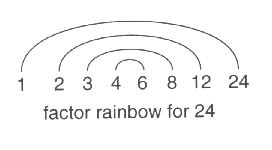September 1 算数の勉強 (1) Math Practice (1) [小学校と銀行]
September 01, 2008 (Monday)
モーリちゃんの学校が28日から始まって、数か月ぶりにまた算数の英語、もしくは英語の算数、の世界にモーリちゃんの父もツカリソウな予感の連休です。
以下、数学が苦手な文系の人は読んだら楽しいかもw。
Fifth Grade Everyday Mathematics という、シカゴ大学の "Universtiy of Chicago School Mathematics Project" (UCSMP) が開発した教材を使うのだそうだが、それの "Study Link 1-1" の "Unit 1: Family Letter" という、3ページにわたるプリントを金曜日に持ち帰ってきました。 1ページ目の最後のところには太字で "Please keepthis Family Letter for reference as your child works through Unit 1." と書かれており、おいおい、親を巻き込んで勉強かい、やっぱり、という感じなのでした。
1-2ページの途中まではこの教材のねらいと特長が書かれているのですが、そのあといきなり "Unit 1: Number Theory" の解説に突入。ページ下のコラムには "Building Skills through Game" というのがあり、UNIT 1 では"Factor Bingo" "Factor Captor" "Multiplication Top-It" "Name That Number" という4つのゲームを楽しんで計算を学んだりもするのだそうで、ふたつめの "Factor Captor"――因数捕獲?――の説明は "See Student Reference Book, page 306. This is a game for 2 players. Materials needed include a Factor Captor Grid 〔因数捕獲碁盤?〕, 48 counters the size of a penny 〔1仙玉サイズの48個の石というかカウンター〕, scratch paper 〔メモ用紙のことですね〕, and a calculator. The goal of the game is to strengthen the skill of finding the factors of a number." と書かれていますが、何をどうするのか実はわかりません。Student Reference Book の306ページを見ろ、と書かれてますけれど、教科書は小学校に置いたままです(それに日本と違って自分のものにはならず借りているので・・・・・・あ、いまモーリちゃんたちと話をしたのですが、こちらに前から住んでる人の話だと社会の本を、古いのを家用にくれた先生がいたそうな・・・・・・去年の話だとみんな教室で終わったところはちぎったりしているようで・・・・・・でもモーリちゃんはそんなことはもったいなくてできないから最後にもらってきたとか・・・・・・よくわからんです)。
あとはVocabulary。composite number A counting number greater than 1 that has more than two factors. For example, 4 is a composite number because it has three factors: 1, 2, and 4. 〔"composite number" は「合成数」と訳されてますけど、そんな言葉でモーリちゃんの父は習っていない気がする。「2以上」は "more than two" で、「1より大きい」が "greater than 1" ですか。整数の場合だと同じだけれど。"counting number" = 自然数(ゼロ以外の正の整数)〕 divisible by If the larger of two counting numbers can be divided by the smaller with no remainder, then the larger is divisible by the smaller. For example, 28 is divisible by 7 because 28 / 7 =4 with no remainder. 〔「割り切れる」ということですね。"remainder" = 余り〕 exponent The small, raised number in exponential notation that tells how many times the base is used as a factor. 〔"raise" 自体が累乗するという意味だと思うし"exponential notation" (これ辞書に出てこないのですが「累乗(法)」 =exponentiation という日本語に相当するのでしょうか)というフレーズが説明に入っているのも辞書的には純粋じゃないのですが(辞書じゃないって)、"exponent" は累乗の指数、「ベキ」ですね〕 factor One of two or more numbers that are multiplied to give a product. 〔因数〕 factor rainbow A way to show factor pairs in a list of all the factors of a number. A factor rainbow can be used to check whether a list of factors is correct. 〔対の約数を結んだ弓形というか虹の形の弧のことらしい。見たような見てないような・・・・・・こんなやつ―― 〕 number model A number sentence or expression that models a number story or situation. 〔計算式、数式〕 prime number A whole number that has exactly two factors: itself and 1. For example, 5 is a prime number because its only factors are 5 and 1. 〔素数。 "whole number" = 整数 (integer)、自然数〕 product The result of multiplying two or more numbers, called factors. 〔積〕 rectangular array A rectangular arrangement of objects in rows and columns such that each row has the same number of objects and each column has the same number of objects. 〔これは方陣とか訳すのかしら。単なる行列というのではないような。matrix ですけど。こんなやつ――
〕 number model A number sentence or expression that models a number story or situation. 〔計算式、数式〕 prime number A whole number that has exactly two factors: itself and 1. For example, 5 is a prime number because its only factors are 5 and 1. 〔素数。 "whole number" = 整数 (integer)、自然数〕 product The result of multiplying two or more numbers, called factors. 〔積〕 rectangular array A rectangular arrangement of objects in rows and columns such that each row has the same number of objects and each column has the same number of objects. 〔これは方陣とか訳すのかしら。単なる行列というのではないような。matrix ですけど。こんなやつ―― "row" は「行」で "column" は「列」で〕、そういえばラインダンスのラインをイギリス英語では "row" と呼ぶのだった、と思いだしましたが、数学ではアメリカでもrow なのですね(lineは別に指すものがあるからかなあ)。それでも rowやline はやっぱり本来横並びなのでしょうね。日本語では「行」と「列」という言葉より「横列」「縦列」という呼び方が今は一般的のようですが、そうなると何が行で何が列かわからなくなりますね。でも文章のラインは「行」と訳されているわけで、縦(書き)でも行と呼んでいたのか、それとも訳なのか――うはっ、すごい脱線w〕 square number A number that is the product of a counting number multiplied by itself. For example 25 is a square number, because 25 = 5 * 5. 〔乗数〕
"row" は「行」で "column" は「列」で〕、そういえばラインダンスのラインをイギリス英語では "row" と呼ぶのだった、と思いだしましたが、数学ではアメリカでもrow なのですね(lineは別に指すものがあるからかなあ)。それでも rowやline はやっぱり本来横並びなのでしょうね。日本語では「行」と「列」という言葉より「横列」「縦列」という呼び方が今は一般的のようですが、そうなると何が行で何が列かわからなくなりますね。でも文章のラインは「行」と訳されているわけで、縦(書き)でも行と呼んでいたのか、それとも訳なのか――うはっ、すごい脱線w〕 square number A number that is the product of a counting number multiplied by itself. For example 25 is a square number, because 25 = 5 * 5. 〔乗数〕
よく、ヨーロッパの言葉では、日常の語彙がそのまま専門的な用語となっている、というようなことが言われますけれど、なんか、そういえばそうかもしれん語とそうではなくてえらく専門的な響きのある語が混然となって、とてもモーリちゃんの父は混乱しています。日本語に直さないでそのまま考えろ、と言われても考えられんよ。なんで exponent がベキ指数なのか、あるいは、ここにはあがってないけれど "mixed number" がなんで帯分数なのか、あるいは "improper fraction" がなんで仮分数なのか、わけがわかりませんわ。こゆうので論理的な思考とやらが育まれるのでしょうか。
factors はmultiply されると product を生じる。なんで足し算ではproduct でも factor でもないのでしょうか。あるfactor に別のfactor がかけあわさってひとつの情況ができる。あるfactor に別のfactor が加わって別の情況ができる、とはならないのね。英英辞典での日常世界でのfactor の意味―― "one of several things that influence or cause a situation: The rise in crime is mainly due to social and economic factors. The weather could be a factor in tommorow's game." ううむ、かけあわさって、というのが英語的意識なのかなあ。Susanna's support was a key factor in Foster's election win. スザンナの支持はフォスターの選挙の勝利の鍵となるファクター〔因数・要素〕だった。あるいは分数とか小数ではfactor にならないのはなぜだろう。3 is a factor of 15. 3 (factor) x 5 (factor) = 15 (product). 1.5 x 10 = 15 (product?) Product is "the result of multiplying two or more numbers, called factors." Then those given "numbers" are already whole numbers? あるいは、削ったり少なくしたり割ったりすることで生まれるproduct というものはないのでしょうか(算数の世界の話だから、といわれれば、それまでのようでいて、それまでのようではない。だったら算数の世界にふつうの言葉を持ち込むなよ、といいたく(も)なるわけです)。
いっぽう、じっさいに教室でやらされたらしい "5th Grade Mountain Math" というプリントを見ると、 1. Write this number. / 1. Is this number even or odd? / 1. Round this number to the nearest 10. / 1. Round this number to the nearest 100. / 1. Round this number to the nearest 1,000. / 1. Round this number to the nearest 10,000. / 1. What is 100 less than this number? / 1. What is 100 more than this number? / 1. What is 1000 less than this number? / 1. What is 1000 more than this number? / 1. Write in expanded notation? / 2. Write this number. / 3. What is this numeral? / 4. Write the numbers. What is the place value of the top digit in each number? . . . . 以下エンエンとw
はっきり言ってわからんす。たぶん "this number" なるものを黒板に書くなりなんなりして始まると思うのですが、かりに12345という数が提示されたとして、最初の偶数か奇数かはいい。だけどそのつぎからの、"Round" で始まる問い、この「丸める」(という言葉をモーリちゃんの母は知っていたように語っていたがモーリちゃんの父はそんな言葉は聞いたことがなかったですけど)というのは概数を出せということですけど、 "to the nearest 10" というのは「10の桁までであらわすとおよそいくらか」みたいなことですかね。12350。だけどなんで "to the nearest 10" がそういう意味になるのでしょう。"more than" "less than" は慣用句的発想を禁じれば問題ないですが。4番のなんかは、まあ確かに "place value" =けた (これ[=けた]は、いちおうネット上で参考になる "English as a Second Language Programs: Math Vacabulary English--Japanese--" [Ann Arbor Public Schools Instructiona Services] の訳ですが) というより言葉に立ち返って、その桁にあることで持っている価値、という考えでわかるのだけれど、しかし・・・・・・むつかしい。 むつかしすぎる。わしでもついていけないと思います。
それで、しょうがないから、しかし貧乏根性でネット上でなんか参考になるものを探しました。 探すときに気になっていたのが分数だったので、とりあえず、
Watch Video on Reducing Fractions - Lowest Terms -
これのFree Video はきれいなおねえさんが 30/75 の通分の説明をしてくれます。だけどなあ、common mistake が最大公倍数いや公約数を5と考えることで、ほんとは15、だから15で割ってみたいな説明だけれど、通分の過程としては5で割るのがあるのが自然なような気もしますが・・・・・・。
Students learn that a fraction is in lowest terms if the Greatest Common Factor of the numerator and denominator is 1. For example, 3/5 is in lowest terms, because the Greatest Common Factor of 3 and 5 is 1. However, 3/6 is not in lowest terms, because the Greatest Common Factor of 3 and 6 is 3. Students also learn that a fraction can be rewritten in lowest terms by dividing the numerator and denominator by their Greatest Common Factor. For example, to write 10/15 in lowest terms, divide the numerator and denominator by their Greatest Common Factor of 5, to get 2/3.
で、あれこれ探しているうちに、Ms. Crawford 先生の部屋(Ms.Crawford's Room) に行きつき、クローフォードさんのブログは文字化けもあったりして消化不能だったけれども、さまざまなリンクがあり、そのなかにちゃんとUCSMP の Everyday Mathematic のページもあったのでした。めでたしめでたし。やっぱりインターネットはリンクですね。そうりんにいたらずとも。クローフォード先生に感謝。
しかし、モーリちゃんに教えるのに、英語と日本語とどのように概念を整理し用語を整理すればよいのか(実は日本語で整理しようにも整理できないとわかっている、だってちゃんとした訳語がないのだもの) 悩んでいるのでした、あたってくだけろか(と書いたときには既にあたって互いにくだけていたのですけれど・・・・・・ははは)。
数学は式だけで万国共通の言語と思っていたのは夢なのでしょうか。苦難はつづく。がんばるぞー!
ブログ村 サンフランシスコ・ベイエリア情報





コメント 0